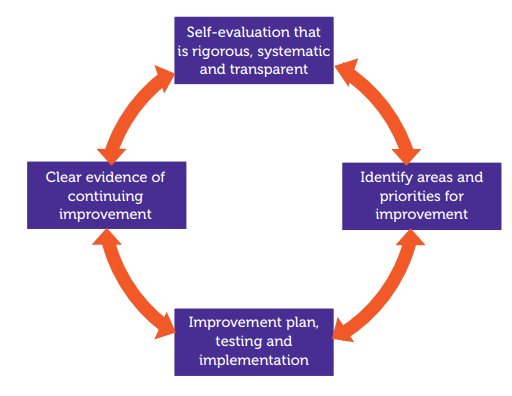![]()
Self-Evaluation
Resources
What is it?
“Self-evaluation involves a continuous process of reflection and development“.
(Realising the Ambition, Education Scotland, 2020, p. 85)
“Self-evaluation is central to continuous improvement. It enables care settings to reflect on what they are doing so they can get to know what they do well and identify what they need to do better… Self-evaluation establishes a baseline – a starting point – from which you can put in place plans with clear priorities for actions that will improve outcomes for people using your service. Used effectively, continuous self-evaluation helps monitor progress and measure the impact that your changes have made on outcomes – the differences made – for people.”
(Self-evaluation for Improvement: Your Guide, Care Inspectorate, 2019, p. 3)
Key messages:
Effective self-evaluation:
- Should be an ongoing process (rather than a one-off) conducted regularly to monitor provision in general and evaluate specific aspects of practice that require improvement.
- Supports improvements to allow practitioners to ensure that a service improves outcomes for children in their care.
- Can focus on a team’s performance, particular processes, or complaints received.
- Is collaborative and includes all practitioners, management or the Senior Leadership Team, so ideas can be discussed as a team, taking different viewpoints into consideration.
- Involves partners, such as parents and families and gathers children’s opinions and contributions.
- It is focused on evaluating current practice in the setting.
- Can involve multiple settings to moderate and quality assure their self-evaluation records and learn together.
- Looks outwards to other settings to support continuous improvement.
- Identifies and records priorities for improvement, planned and recorded with clear criteria for success.
- Highlights key practitioners responsible for implementation, with transparent and manageable time scales.
- Should be evidenced so that the impact changes outcomes for children are recorded through observation, tracking and monitoring children’s progress, or gathering feedback from partners.
- It is communicated and shared to all partners, e.g. parents, families and stakeholders, where appropriate.
- Includes reflection and evaluation of improvements, which feeds into the next round of self-evaluation.
- Is informed by national and local guidance, frameworks and documents, e.g. The New Quality Improvement Framework For Early Learning & Childcare
- Ensure that improvement targets are SMART (Care Inspectorate Hub bitesize):
- Specific – what improvement needs to be accomplished?
- Measurable – how will you know you have reached your aim? What is the evidence?
- Achievable – is this aim possible to achieve?
- Relevant – does the aim matter to the setting?
- Time-bound – when will the aim be accomplished?
Ways we can do this:
Ensure time is allocated for self-evaluation at specific points during the year. A monitoring or quality assurance calendar or KanBan board would support and evidence this.
Try integrating the self-evaluation process before any improvements you make in the setting. Looking at one particular area of practice to improve, consider:
- How are we doing now with this area?
- What do the documents say about this area? Use the quality indicators to make a baseline assessment.
Ask all stakeholders these same questions, gather ideas from everyone and move forward this way. Evidence this in a manageable way.
Ensure all contributors to self-evaluation recognise and understand that the process is focused on identifying what a service is doing well and areas for improvement.
Define the purpose of self-evaluation, is it aimed at a specific area or is it more of a general overview that will take more time.
Ensure the timing to discuss the planned self-evaluation is convenient for most practitioners to attend.
Invite members of the Senior Leadership Team or management in advance. In Private and Voluntary settings, consult with the Board of Trustees.
Invite parents to participate in the process, either in person or via an online survey if appropriate.
Children’s ideas and viewpoints can be gathered through discussions, observation of play, or reflecting on photographs or videos.
Where different settings have a shared development goal, e.g. learning environment or outdoor learning, nominate practitioners to meet to conduct self-evaluation together, sharing good practice and learning from each other’s self-evaluating techniques.
Engaging with professional discussion with practitioners from other settings, joining professional discussion groups virtually, visiting different settings, or looking at photographs from ideas they have had. Trying to search the internet for good ideas or joining social media groups to see how specific areas have been developed.
Ensure the responsible practitioner has the appropriate time given to accomplish their tasks. Record actions and collect evidence to measure the impact of change over time.
The use of newsletters or other methods of communication to ensure parents and other partners are informed about the implementation of improvements. The use of video tours can be a highly effective method to illustrate changes to the environment for both current and prospective families.
Ensure opportunities for practitioners to meet to discuss the progress of the development and evaluate the impact upon children’s learning.
Gather evidence of impact through observations, tracking and feedback from practitioners, children and parents. Highlight the positive improvement and impact on the setting.
Linked Areas of Practice
Data
Pedagogical Leadership
Peer Observation
Self-Evaluation – worked example
Tracking, Monitoring & Assessment
Vision, Values & Aims
Tools
Reflecting on Practice
SBC Guidance to support
National Guidance to support
Further Reading to support
Training to support
Highlight Key Documents using iBooks in iPad
Use Microsoft Forms to get feedback from stakeholders
